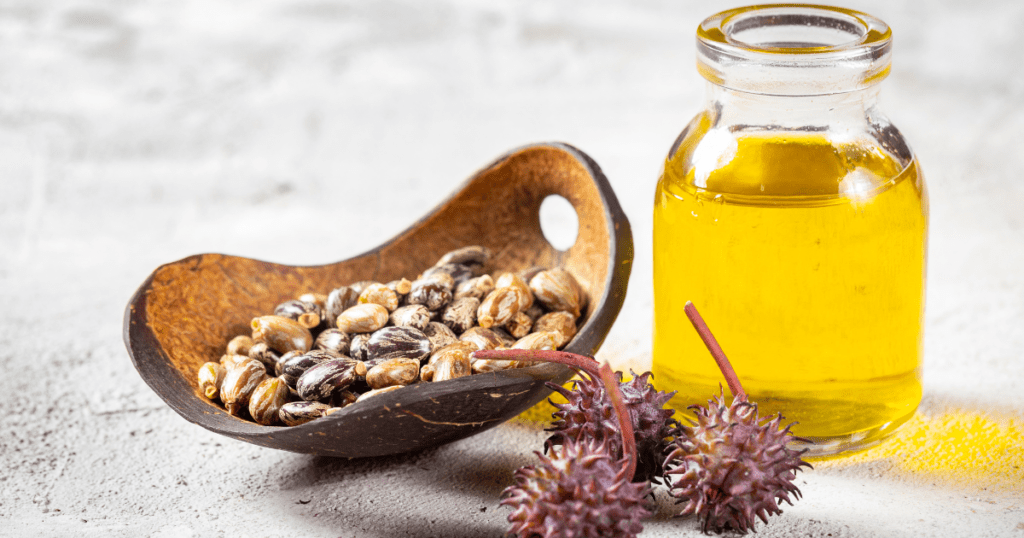Back pain, a widespread affliction affecting millions globally, transcends mere physical discomfort to significantly impact daily life and overall well-being. In the quest for natural alternatives to assuage this pervasive issue, castor oil emerges as a promising and multifaceted remedy. This article delves deeper into the use of castor oil for back pain relief.
Understanding Back Pain
Causes and Common Symptoms
Back pain, a universal concern affecting millions globally, is a complex issue with diverse roots. The causes are multifaceted, ranging from lifestyle choices to underlying medical conditions. Poor posture, a common culprit, places undue stress on the spine and supporting muscles. Muscle strain, often a result of lifting heavy objects or sudden movements, can trigger discomfort. Underlying medical conditions such as herniated discs or arthritis contribute to chronic back pain.
Recognizing the symptoms early is paramount for effective intervention. Stiffness, a prevalent sign, indicates potential muscle tension or inflammation. Shooting pain, whether localized or radiating, may signify nerve compression. Understanding these symptoms not only aids in identifying the root cause but also facilitates a more targeted approach to alleviating back pain.

Importance of Addressing Back Pain Early
The adage “prevention is better than cure” holds profound significance when it comes to back pain. Ignoring early signs can lead to chronic issues that significantly impact daily life and overall well-being. The consequences extend beyond mere discomfort, affecting mobility, productivity, and quality of life.
Early intervention is a key player in mitigating long-term discomfort. Simple lifestyle adjustments, coupled with targeted remedies like castor oil, can make a substantial difference. Whether through ergonomic changes in the workspace, regular exercise, or adopting back-friendly habits, addressing back pain at its onset is crucial for preventing its progression into a chronic and debilitating condition.
Moreover, early intervention can help individuals avoid the need for more invasive treatments down the line. By proactively managing back pain, individuals can reduce their reliance on medications or surgical interventions, promoting a more sustainable and holistic approach to well-being.
Exploring Castor Oil for Back Pain
Historical Uses of Castor Oil
The journey of castor oil through the annals of history is a testament to its enduring significance as a medicinal elixir. Dating back centuries, castor oil has traversed diverse cultures and medical traditions, establishing itself as a versatile remedy. Its applications in traditional medicine have been woven into the fabric of ancient civilizations, where its efficacy was revered and its uses manifold.
In traditional medicine, castor oil found applications in treating a myriad of ailments. Ancient civilizations recognized its potent properties, utilizing it as a remedy for gastrointestinal issues, and skin conditions, and even as a general health tonic. The Egyptians, renowned for their medical advancements, employed castor oil for various therapeutic purposes, showcasing its widespread acceptance across different cultures.
Beyond its medicinal applications, castor oil held ceremonial significance in certain cultures. Its purity and perceived healing abilities elevated it to a substance used in rituals and religious practices, underscoring the reverence bestowed upon this natural remedy.
Composition and Potential Benefits
Central to castor oil’s efficacy are its unique composition and rich reservoir of beneficial compounds. At the heart of its potency lies ricinoleic acid, a monounsaturated fatty acid renowned for its anti-inflammatory and analgesic properties. This key component gives castor oil its ability to combat inflammation, making it a valuable asset in various therapeutic applications.
The anti-inflammatory properties of castor oil extend beyond mere alleviation of symptoms; they hold the potential to foster healing. By mitigating inflammation, castor oil creates an environment conducive to the body’s natural healing processes. This dual-action mechanism positions castor oil as not only a symptomatic relief provider but also as a catalyst for addressing the root causes of various health issues.
Additionally, castor oil’s composition includes other beneficial compounds such as antioxidants and essential fatty acids. These elements contribute to its overall health-promoting effects, further enhancing its status as a comprehensive natural remedy.
How Castor Oil Works for Pain Relief

The efficacy of castor oil in providing relief from pain, particularly in the context of sore muscles, stems from its unique ability to penetrate deep into tissues. Unlike superficial solutions, castor oil’s composition allows it to reach the core of discomfort, addressing the underlying causes of pain.
As castor oil permeates tissues, it exerts its anti-inflammatory effects, reducing swelling and alleviating pain. This dual-action approach distinguishes castor oil from conventional pain relief methods, making it a holistic solution that not only soothes symptoms but actively contributes to the healing process.
Applying Castor Oil for Back Pain
Choosing the Right Castor Oil
Selecting the right castor oil is a crucial step in optimizing its effectiveness for alleviating back pain. The market offers a plethora of options, ranging from conventional to organic variants. Opting for a high-quality, organic castor oil ensures not only the purity of the product but also the preservation of its beneficial properties.
High-quality castor oil is derived from organic castor beans, cultivated without the use of pesticides or synthetic fertilizers. This ensures that the final product remains uncontaminated by harmful chemicals, preserving its natural healing potential. Understanding the sourcing and production processes, as indicated on labels, becomes imperative in making an informed decision.
Labels and certifications play a pivotal role in discerning the quality of castor oil. Look for certifications such as USDA Organic or Cold-Pressed, which affirm the authenticity and purity of the oil. These designations indicate that the oil has been extracted without heat, preserving its essential nutrients and ensuring a premium product. By scrutinizing labels and certifications, consumers empower themselves to make wise and health-conscious purchases.
Methods of Application
The versatility of castor oil extends to its various application methods, allowing users to tailor their experience based on individual preferences. Simple massages, employing the hands to gently rub castor oil onto the affected area, offer a convenient and accessible method. This approach promotes relaxation and directly targets muscle tension.
For those seeking a more intensive application, castor oil packs provide an alternative. By soaking a cloth in castor oil and applying it to the affected area, users create a localized treatment that enhances absorption. This method is particularly effective for addressing larger areas or providing prolonged exposure to the oil.
The flexibility in application methods accommodates a spectrum of preferences. Whether opting for the simplicity of a massage or the extended benefits of castor oil packs, users can experiment to discover the approach that resonates most effectively with their bodies and lifestyles.
Safety Precautions
While castor oil is generally safe for external use, it’s crucial to exercise prudence and be aware of potential allergic reactions. Before incorporating castor oil into a back pain relief routine, conducting a patch test on a small area of skin is advisable. This precautionary measure helps identify any sensitivity or adverse reactions.
Consulting with a healthcare professional before using castor oil is particularly important for individuals with pre-existing conditions, skin sensitivities, or allergies. While rare, allergic reactions may occur, emphasizing the need for personalized advice to ensure a safe and effective experience.
Scientific Perspective
Research Studies on Castor Oil for Pain
The scientific exploration of castor oil’s potential for pain management has yielded valuable insights, contributing to the growing body of evidence supporting its efficacy. Numerous research studies have delved into the anti-inflammatory and analgesic properties inherent in castor oil, shedding light on its therapeutic effects for alleviating pain.
These studies have specifically investigated the mechanisms through which castor oil exerts its anti-inflammatory actions. The presence of ricinoleic acid, a prominent component in castor oil, has been a focal point in these inquiries. Ricinoleic acid, renowned for its anti-inflammatory nature, has demonstrated the ability to inhibit inflammatory pathways and reduce the production of pro-inflammatory compounds. This biochemical activity positions castor oil as a natural agent capable of modulating inflammation, a crucial aspect in addressing pain associated with conditions such as back pain.
Expert Opinions and Medical Community Insights
In addition to empirical research, the acknowledgment of castor oil’s potential benefits comes from experts within the medical community. Professionals in the field recognize castor oil as a valuable and complementary therapy for managing back pain. Their insights, grounded in both clinical experience and an understanding of the biochemical properties of castor oil, contribute to the broader acceptance of this natural remedy.
Experts often emphasize the importance of a holistic approach to pain management, and castor oil fits seamlessly into this paradigm. Its anti-inflammatory properties, coupled with its ability to promote healing, align with the principles of comprehensive well-being. Medical practitioners and experts in complementary medicine recognize that castor oil can be a valuable adjunct to traditional treatments, offering patients an additional avenue for relief.
The medical community’s endorsement of castor oil encourages individuals to consider this natural remedy as part of their back pain management plan. As these expert opinions become more widely recognized, the integration of castor oil into conventional healthcare practices may continue to grow, fostering a collaborative approach to addressing the multifaceted nature of back pain.
Integrating Castor Oil into Daily Routine
Incorporating Castor Oil in Self-Care Practices
The integration of castor oil into daily self-care practices provides a holistic approach to pain management, ensuring consistent and comprehensive well-being. This versatile natural remedy offers a spectrum of applications, from traditional warm compresses to the creation of infused oils, catering to individual preferences and enhancing the overall self-care experience.
Warm compresses are a classic and accessible way to incorporate castor oil into daily routines. By soaking a cloth in warm castor oil and applying it to the affected area, individuals not only experience the soothing warmth but also allow the oil to penetrate deeply, providing targeted relief. This simple yet effective practice can be seamlessly woven into morning or evening rituals, fostering a sense of comfort and relaxation.
Long-Term Benefits and Considerations
Understanding the long-term benefits of incorporating castor oil into daily life fosters a perspective of sustainability and commitment to overall well-being. Castor oil’s multifaceted nature goes beyond providing immediate relief; it offers long-term advantages that contribute to a healthier lifestyle.
Consistent application of castor oil may lead to a reduction in inflammation over time, addressing not only the symptoms but also the underlying causes of pain. This sustained anti-inflammatory effect positions castor oil as a proactive and preventive measure, potentially minimizing the recurrence of pain episodes.
Moreover, castor oil’s ability to promote healing adds an extra layer of long-term benefits. By fostering a conducive environment for the body’s natural healing processes, individuals may experience improved tissue health and resilience, contributing to a sustained sense of well-being.
Addressing Common Misconceptions
Debunking Myths Around Castor Oil
Clearing misconceptions ensures readers make informed decisions about incorporating castor oil into their pain management routine.
Clarifying Its Limitations
While beneficial, castor oil has its limitations. Understanding these allows users to set realistic expectations.
Precautions and Consultation
Advising Consultation with Healthcare Professionals
Prioritizing safety and effectiveness in pain management necessitates seeking advice from healthcare professionals before incorporating new remedies. Before venturing into the application of castor oil for pain relief, consulting with a healthcare professional becomes a crucial first step. This ensures that the chosen approach aligns with an individual’s unique health profile, preventing potential complications and optimizing the overall effectiveness of the chosen remedy.
Healthcare professionals bring a wealth of knowledge and expertise, offering personalized insights based on an individual’s medical history, existing conditions, and overall health status. Their guidance not only enhances the safety of the pain management journey but also tailors the approach to address specific concerns or considerations.
Potential Contraindications and Warnings
While castor oil is generally safe for external use, individuals with specific medical conditions or allergies should exercise caution and seek professional advice before incorporating it into their pain management routine. Potential contraindications and warnings may exist for individuals with skin sensitivities, allergies to castor beans, or certain medical conditions.
A healthcare professional can provide personalized guidance, conducting a thorough assessment to determine the suitability of castor oil for an individual’s unique circumstances. This proactive approach ensures that any potential risks are identified and addressed, allowing individuals to make informed decisions about the integration of castor oil into their pain management regimen.
Purchasing Quality Castor Oil
In a market saturated with various options, ensuring the acquisition of high-quality castor oil is paramount for optimal results. Readers are advised to prioritize reputable sources and established brands, leveraging customer reviews and expert recommendations. This careful selection process minimizes the risk of obtaining subpar products, promoting confidence in the efficacy of the chosen castor oil.
Identifying Genuine Products
Safeguarding against subpar alternatives involves discerning genuine castor oil products from potential imitations. Readers are encouraged to be wary of excessively low prices, as quality castor oil is an investment. Recognizing reputable sellers, scrutinizing product descriptions, and checking for third-party testing can serve as indicators of authenticity. By arming themselves with knowledge, consumers can navigate the market with confidence, ensuring that they receive genuine and effective castor oil.
Reading Labels and Understanding Certifications
Deciphering labels and understanding certifications is a crucial step in the purchasing process. Readers are guided to look for prominent certifications such as USDA Organic or Cold-Pressed, affirming the quality and purity of the castor oil. Familiarity with industry standards and certifications empowers consumers to make informed choices, aligning their purchases with established quality benchmarks. This knowledge becomes a valuable tool in selecting castor oil that not only meets but exceeds their expectations in terms of effectiveness and safety.
Don’t Miss: Magical Benefits of Chest Massage: Revitalize Your Well-Being
User Tips and Recommendations
Tips for Effective Application
- Application Frequency: Consistency is key. Apply castor oil regularly, but find a frequency that suits your schedule and skin sensitivity. Two to three times a week is a good starting point for many individuals.
- Skin Preparation: Ensure the targeted area is clean and free from other products. This allows the castor oil to be absorbed more effectively, maximizing its benefits.
- Massage Techniques: When applying castor oil through massage, use gentle, circular motions. This not only aids in absorption but also provides a soothing experience.
- Warm Compress Enhancement: If using a warm compress, ensure it’s comfortably warm but not too hot. The warmth enhances the oil’s penetration and can further relax muscles.
- Experiment with Castor Oil Packs: Explore the use of castor oil packs for larger areas or prolonged exposure. This method can be particularly effective for addressing broader pain concerns.
Dos and Don’ts for Optimal Results
Dos:
- Patch Test: Before widespread application, conduct a patch test on a small area of skin to check for any adverse reactions.
- Choose Quality: Opt for high-quality, organic castor oil. Look for certifications like USDA Organic or Cold-Pressed, ensuring purity and effectiveness.
- Maintain Consistency: Consistent application yields better results. Make castor oil a regular part of your routine for long-term benefits.
Don’ts:
- Excessive Use: Avoid using excessive amounts of castor oil. A little goes a long way, and using too much may not yield better results.
- Overlook Allergic Reactions: If you experience any skin irritation or allergic reactions, discontinue use immediately and seek medical advice.
- Rely Solely on Castor Oil: While castor oil can be beneficial, it’s advisable to complement its use with other healthcare approaches for a comprehensive solution.
Conclusion
In conclusion, castor oil emerges as a natural and promising solution for back pain. From its historical uses to scientific backing and real-life success stories, the multifaceted approach of castor oil offers a holistic means of managing discomfort. By understanding its application, addressing misconceptions, and seeking professional advice when needed, individuals can confidently explore the benefits of castor oil.
FAQs
1. Is castor oil safe for everyone to use?
- While castor oil is generally safe for external use, individuals with specific medical conditions or allergies should consult with a healthcare professional before incorporating it into their routine.
2. Can castor oil be used during pregnancy?
- Pregnant individuals should consult with their healthcare provider before using castor oil, as there may be concerns about its safety during pregnancy.
3. How long does it take to see results when using castor oil for back pain?
- The timeframe for experiencing results can vary among individuals. Consistent application over several weeks is often recommended for optimal outcomes.
4. Can castor oil be used in combination with other pain relief methods?
- Yes, castor oil can be used in conjunction with other pain relief methods. However, it’s advisable to consult with a healthcare professional to ensure compatibility and avoid potential interactions.
5. What is the difference between cold-pressed and regular castor oil?
- Cold-pressed castor oil is extracted without heat, preserving more of its natural properties. It is often considered of higher quality compared to regular castor oil, which may undergo processes that diminish some of its beneficial compounds. Choosing cold-pressed ensures a more potent and effective product.
